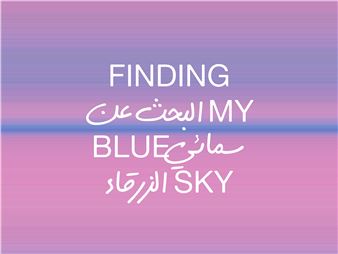Judith Wright: Asemic Writing: Vibration
Judith WrightвҖҷs art concerns, in her words, вҖҳthe slippages of communicationвҖҷ. WrightвҖҷs new works for Asemic Writing: Vibration on paper and linen can be seen as three trios and one duet that explore related sensibilities. First the trio of monochromatic silhouettes, second the trio of symbolic and diagrammatic paintings, third the trio of lyrical and avian forms in intense hues, and finally the duet of intimate exchange between two people. The connecting thread throughout these groupings is JudithвҖҷs recent use of asemic writing as an anamorphic or sideways gesture towards the possibility of communication.
Asemic writing literally has no semantic meaning, these are marks that allude to writing or characters yet settle in the вҖҳalmost becomingвҖҷ of language, where meaning is left to the viewer to decide and, in turn, complete the work. The history of asemic writing is traced to the early ninth century Chinese calligraphers Zhang Xu and Huaisu and appears in Japanese calligraphy and poetry, through to active use by the twentieth centuryвҖҷs Man Ray, Cy Twombly and Max Ernst. The term was coined in 1997 by two visual poets, the Australian Tim Gaze and the American Jim Leftwich.
While visual references such as the South Asian tradition of diagrammatic and symbolic Tantric painting can be drawn, the visual references overwhelmingly refer to WrightвҖҷs own archival world of imagery that has found form through her paintings, artist books, installations, videos and installations spanning six decades. Wright draws more from literature and theatre than from other visual artists. Her early artistвҖҷs book Trace, 1998, quotes from the 10th writer century Izumi Shikibu, one of the most exquisite poets in Japanese literature. ShikibuвҖҷs poems assumed two modes: one served as a vehicle for self-reflection, the monologue poem; while the other served as a means of communication between two people and could be described as the dialogue or exchange poem. One might consider WrightвҖҷs works here as both a vehicle for reflection and as dialogue poems as they inhabit the fraught and fluid space of human and animal emotion, empathy and understanding.

Recommended for you
Judith WrightвҖҷs art concerns, in her words, вҖҳthe slippages of communicationвҖҷ. WrightвҖҷs new works for Asemic Writing: Vibration on paper and linen can be seen as three trios and one duet that explore related sensibilities. First the trio of monochromatic silhouettes, second the trio of symbolic and diagrammatic paintings, third the trio of lyrical and avian forms in intense hues, and finally the duet of intimate exchange between two people. The connecting thread throughout these groupings is JudithвҖҷs recent use of asemic writing as an anamorphic or sideways gesture towards the possibility of communication.
Asemic writing literally has no semantic meaning, these are marks that allude to writing or characters yet settle in the вҖҳalmost becomingвҖҷ of language, where meaning is left to the viewer to decide and, in turn, complete the work. The history of asemic writing is traced to the early ninth century Chinese calligraphers Zhang Xu and Huaisu and appears in Japanese calligraphy and poetry, through to active use by the twentieth centuryвҖҷs Man Ray, Cy Twombly and Max Ernst. The term was coined in 1997 by two visual poets, the Australian Tim Gaze and the American Jim Leftwich.
While visual references such as the South Asian tradition of diagrammatic and symbolic Tantric painting can be drawn, the visual references overwhelmingly refer to WrightвҖҷs own archival world of imagery that has found form through her paintings, artist books, installations, videos and installations spanning six decades. Wright draws more from literature and theatre than from other visual artists. Her early artistвҖҷs book Trace, 1998, quotes from the 10th writer century Izumi Shikibu, one of the most exquisite poets in Japanese literature. ShikibuвҖҷs poems assumed two modes: one served as a vehicle for self-reflection, the monologue poem; while the other served as a means of communication between two people and could be described as the dialogue or exchange poem. One might consider WrightвҖҷs works here as both a vehicle for reflection and as dialogue poems as they inhabit the fraught and fluid space of human and animal emotion, empathy and understanding.












